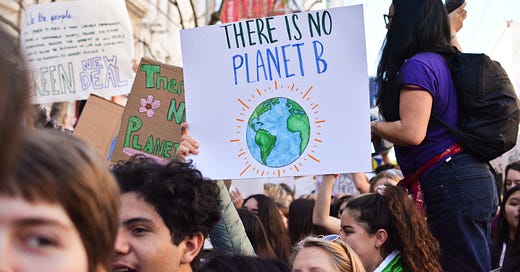An intro to climate solutions
Climate change is the result of overlapping systemic problems; it will take overlapping systemic solutions to fix it
Despite its immensity, the Earth’s resources are not infinite, and it’s clear we’ve exceeded its limits. But it’s also resilient. We can save our planet if we commit to it. - Yvon Chouinard
Despite rampant “climate doomism” and negative media coverage, we’ve made good progress in the fight against climate change. Even so, most climate models still indicate that we’ll be well short of our emissions and temperature goals if we don’t do more, and fast.
There are three overlapping problems we will need to solve if we want to stop and ultimately reverse climate change:
Big Problem #1: Emissions from human activity cause climate change (mostly the burning of fossil fuels for electricity & heat, transport, and industrial processes, as I wrote in my last post)
Big Problem #2: CO2 stays in the atmosphere for a really long time, to the tune of 300-1000 years, so its warming effect endures long after it enters the atmosphere
Big Problem #3: The damage we’ve done to the climate is already affecting life on Earth (recent examples include flooding in Pakistan, drought in Europe, and wildfires in California)
The emissions problem is the beginning of a vicious reinforcing feedback loop. If we keep emitting greenhouse gases, we’ll continue warming the planet for generations to come. Even if we do stop emitting, we have to deal with the effects of the changes we’ve already caused.
What are we to do?
One thing we can’t do is rely on singular solutions. For example, we can’t stop climate change simply by generating more energy from renewable and low-carbon sources. As I wrote in my last post, increasing renewable energy capacity isn’t a silver bullet solution because the systems that use energy still need fossil fuels (over 80% of energy consumption globally).
Fossil fuels are the immediate cause of most emissions, but they aren’t the root of the problem (remember the system iceberg?). Therefore, we simultaneously need more renewable energy and systems designed to use it to reduce our energy emissions.
It should come as no surprise that systemic problems require systemic solutions. That’s why we need multiple overlapping solutions and a holistic, cross-system approach to accomplish three broad goals (related to the three Big Problems I highlighted earlier):
Reducing (and eventually eliminating) emissions from all systems
Removing carbon from the atmosphere to limit warming from prior emissions
Adapting to climate change to deal with its current & future effects
If this sounds daunting, it is. We need to make progress in these three areas at the same time, across multiple complex systems, with a combination of tech, investment, policy, behavior change, business model innovation, and more. And we have to do all of this without creating new Big Problems or exacerbating other systemic problems like inequality and hunger.
Ultimately, we need to redesign the systems at the root of climate change to stop it.
Over the next few weeks, I’ll dive into each solution area—emissions reduction, carbon removal, and adaptation—to highlight specific solutions needed, how they overlap, where we’re making good progress, and where we’re falling short.
Thanks for reading!



